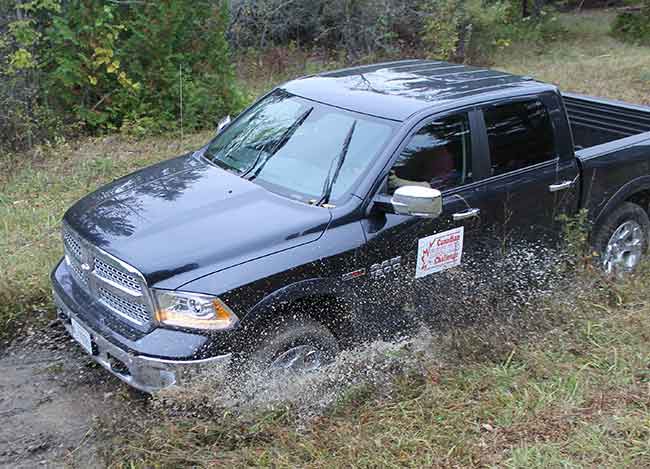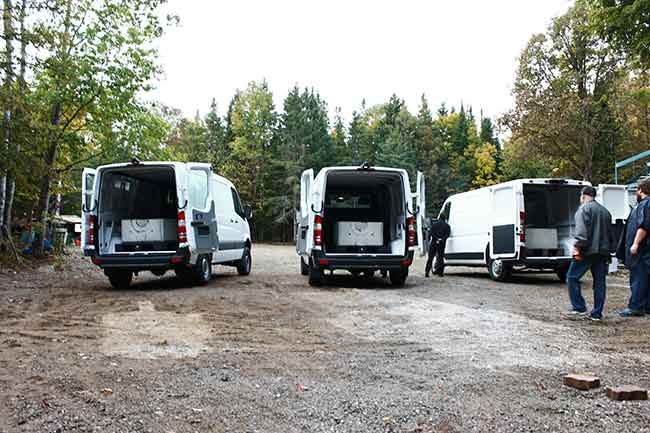
Features
Business
Operations
Truck King Challenge: Winter 2016
Numbers you can use from real-world test-drivers
January 19, 2016 By Howard J Elmer
 The overall top scoring 2016 Canadian Truck King Challenge winner is the Ram 1500, Laramie, 3L EcoDiesel, V6, diesel, 8-speed Auto. Photos courtesy Truck King Challenge
The overall top scoring 2016 Canadian Truck King Challenge winner is the Ram 1500, Laramie, 3L EcoDiesel, V6, diesel, 8-speed Auto. Photos courtesy Truck King ChallengeFor the past nine years veteran automotive journalists have donated their time to act as judges in the only annual North American truck competition that tests pickup and van models head to head – while hauling payload and also towing.
The Canadian Truck King Challenge started in 2006, and each year these writers return because they believe in this straightforward approach to testing and they know their readers want the results it creates.
I started it (and continue to do it) for the same reason – that and my belief that after 40 years of putting trucks to work I know what’s important to Canadians. Now, that’s a long list of qualifications, but in a nutshell it’s the concept that a truck can be pretty, but that alone is just not enough – it also better do its job – and do it well.
This year, nine judges travelled from Quebec, Saskatchewan and across Ontario to the Kawartha Lakes Region where we test the trucks each year. All the entries are delivered to my 70-acre IronWood test site days before the judges arrive so we can prepare them for hauling and towing. In the meantime they are all outfitted with digital data collectors. These gadgets plug into the USB readers on each vehicle and transmit fuel consumption data to a company in Kitchener, Ont. (MyCarma) who records, compiles and translates those readings into fuel economy results that span the almost 4,000 test kilometres that we accumulate over two long days.
These results are as real world as it gets. The numbers are broken into empty runs, loaded results and even consumption while towing. Each segment is measured during test loops with the trucks being driven by five judges – one after the other. That’s five different driving styles, acceleration, braking and idling (we don’t shut the engines down during seat changes).
The Head River test loop itself is also a combination of road surfaces and speed limits. At 17 kilometres long it runs on gravel, secondary paved road and highway. Speed limits vary from 50 to 80 km/h and the road climbs and drops off an escarpment-like ridgeline several times; plus it crosses the Head River twice at its lowest elevation. The off-road part of our testing is done on my own course at IronWood. Vans are not tested on the off-road though it’s noteworthy that the Mercedes Sprinter was equipped with a four-wheel drive system this year.
This is the third year that we have used the data collection system and released the final fuel consumption report that MyCarma prepares for the Truck King Challenge. It’s become one of our most anticipated results.
But how do we decide what to test? Well, as anyone who’s bought a truck knows, the manufacturers never sleep; they bring something different to market every year. As the Challenge looks to follow market trends, what and how we test must change each year too. We had a field of 14 contenders at IronWood this year covering four categories. They were as follows:
Full-Size Half-Ton Pickup Truck
- Ford F-150, Platinum, 3.5L, V6 EcoBoost, gas, 6-speed Auto
- Ford F-150, XLT, 2.7L, V6 EcoBoost, gas, 6-speed Auto
- Chevrolet Silverado, High Country, 6.2L, V8, gas, 8-speed Auto
- Ram 1500, Laramie, 3L EcoDiesel, V6, diesel, 8-speed Auto
Mid-Size Pickup Truck
- Toyota Tacoma, TRD Off-Road, 3.5L V6, gas, 6-speed Auto
- GMC Canyon, SLT, 2.8L Duramax, I-4 diesel, 6-speed Auto
- Chevrolet Colorado, Z71, 3.6L V6, gas, 6-speed Auto
Full-Size Commercial Vans
- Ford Transit 250, 3.2L Power Stroke I-5 diesel, 6-speed Auto
- Mercedes Sprinter 2.0L BLUE-Tec I-4 diesel, 2X4
- Mercedes Sprinter 3.0L BLUE-Tec V6 diesel, 4X4
- Ram ProMaster 1500, 3,0L I-4 diesel, 6-speed Auto/Manual
Mid-Size Commercial Vans
- Ram ProMaster City, SLT, 2.4L Tigershark I-4 gas, 9-speed Auto
- Nissan NV200, 2.0L I-4, gas, Xtronic CVT Auto
- Mercedes Metris, 2.0L I-4, gas, 7-speed Auto
These vehicles are each all-new or have significant changes made to them. However, this year the Truck King Challenge decided to try something else new by offering a returning champion category.
This idea had been growing for a while having everything to do with the engineering cycles that each manufacturer follows. Simply put, trucks are not significantly updated each year and to date we have only included “new” iron in each year’s competition. However, we started to think that just because a truck is in the second or third year of its current generational life shouldn’t make it non-competitive.
So, this spring we decided that the immediate previous year’s winner (in each category) would be offered the chance to send its current truck to compete against what’s new on the market.
This year the invitation was sent to the Ram 1500 EcoDiesel, Ford Transit 250 and Nissan NV200 – all previous winners that accepted the offer to return and fight for their crowns.
They, along with the new vehicles, took the tests over two days with the judges evaluating everything from towing feel to interior features.
The judges score each vehicle in 20 different categories; these scores are then averaged across the field of judges and converted to a score out of 100. Finally the “as tested” price of each vehicle is also weighted against the average (adding or subtracting points) for the final outcome.
And this year’s segment winners are…
- Full-Size Half-Ton Pickup Truck – Ram 1500 EcoDiesel – 82.97%
- Mid-Size Pickup Truck – GMC Canyon Duramax – 76.30%
- Full-Size Commercial Van – Ford Transit 250 – 73.90%
- Mid-Size Commercial Van – Mercedes Metris – 75.69%
The overall top scoring 2016 Canadian Truck King Challenge winner is the Ram 1500, Laramie, 3L EcoDiesel, V6, diesel, 8-speed Auto.
Congratulations to the winners and to the two repeating champions – the Ram 1500 EcoDiesel and the Ford Transit 250.
Print this page
